Holly Thompson's Blog, page 39
March 31, 2011
Wakame Recipes and Teaching East Asia Through Children's Literature
My picture book
The Wakame Gatherers
was featured in the 2008 Program for Teaching East Asia (TEA) Summer Study Tour. Teachers and librarians joined me in Kamakura where, although it was not wakame season, we visited the local sites featured in the book and met up with Hatsuko Kimura, the model for the character Baachan.

After walking about town, we went to a school where community members met the group

and everyone cooked together
 preparing a wakame feast
preparing a wakame feast
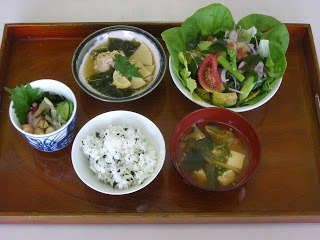 that was devoured.
that was devoured.
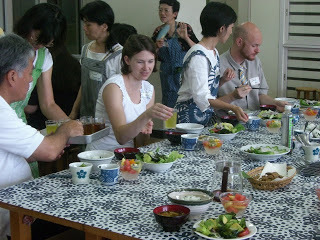 I wrote about the day in a Shen's Books blog post Cross-Cultural Connections Through Wakame and TEA has compiled "Texts and Contexts: Teaching Japan Through Children's Literature".
I wrote about the day in a Shen's Books blog post Cross-Cultural Connections Through Wakame and TEA has compiled "Texts and Contexts: Teaching Japan Through Children's Literature".
Since now is still wakame season in much of Japan when fresh wakame is readily available, if you are looking for some new and traditional ways to use wakame, try these wakame recipes (scroll down to the lower left corner of the web page), collected by the community and put together for the TEA event in Kamakura. Enjoy!

After walking about town, we went to a school where community members met the group

and everyone cooked together
 preparing a wakame feast
preparing a wakame feast that was devoured.
that was devoured. I wrote about the day in a Shen's Books blog post Cross-Cultural Connections Through Wakame and TEA has compiled "Texts and Contexts: Teaching Japan Through Children's Literature".
I wrote about the day in a Shen's Books blog post Cross-Cultural Connections Through Wakame and TEA has compiled "Texts and Contexts: Teaching Japan Through Children's Literature".Since now is still wakame season in much of Japan when fresh wakame is readily available, if you are looking for some new and traditional ways to use wakame, try these wakame recipes (scroll down to the lower left corner of the web page), collected by the community and put together for the TEA event in Kamakura. Enjoy!
Published on March 31, 2011 01:31
March 12, 2011
Earthquakes, tsunami waves, reactors
My heart aches. Of all the times for me to be away from my family in Japan! I arrived in the U.S. for readings, research and a working retreat the day before the massive earthquake off the coast of Sendai. The devastation from the quakes, tsunami, landslides, fires and damaged nuclear power plant reactors in northeastern Japan is difficult to grasp. The images are terrifying. My family is safe, our home, located south of Tokyo, is undamaged. But we who live in coastal areas of earthquake-prone Japan are all too aware it could easily have been us racing to evacuate from our low-lying areas to the nearest high ground before the waves smashed.
I anxiously await every update from my family. I remain glued to livestream news from Japan (in Japanese--NHK, TBS), twitter, facebook, blogs. And I am thinking of all my friends, colleagues, students and their families from northern Japan and hope they are miraculously safe and well. My heart is in Japan.
I anxiously await every update from my family. I remain glued to livestream news from Japan (in Japanese--NHK, TBS), twitter, facebook, blogs. And I am thinking of all my friends, colleagues, students and their families from northern Japan and hope they are miraculously safe and well. My heart is in Japan.
Published on March 12, 2011 20:09
March 7, 2011
Wakame Gathering in Japan; The Wakame Gatherers to Cambodia
January to March is wakame season in Kamakura, when wakame seaweed is harvested from the ropes hung between moorings in the bay and, under careful monitoring, cut from rock beds. Here are a few photos to show the process.
A boatload of wakame has been brought up onto the beach and unloaded and now only contains a basket full of mekabu (the curvy part near the base).

The wakame fronds are immersed in boiling water, then lifted out of the cauldron for cooling and hanging.

Fishing family members hang the wakame.
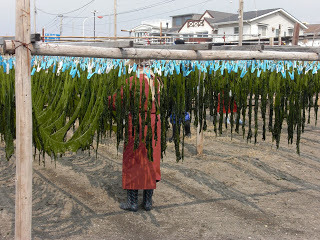
Fronds are split open to dry better.
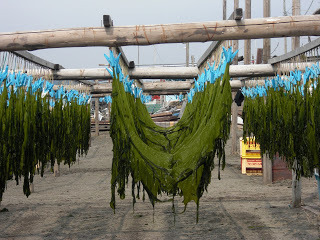
At the end of a day in the sun, the wakame is nearly black, dry and crispy.
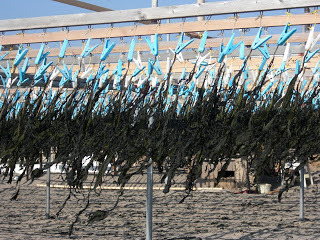
Some people venture into the waves to collect their own wakame, especially on a day like this when the surf is calm.
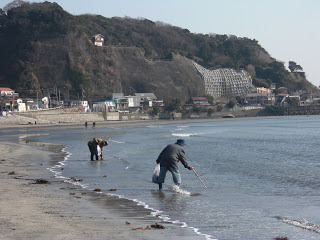
Last month, I traveled to Cambodia with The Wakame Gatherers. I visited the International School of Phnom Penh...

and the one-room Butterfly School in the village of Bopeae
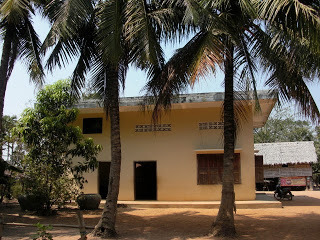
where The Wakame Gatherers was added to their bookshelf.
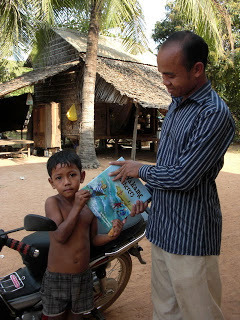

A boatload of wakame has been brought up onto the beach and unloaded and now only contains a basket full of mekabu (the curvy part near the base).

The wakame fronds are immersed in boiling water, then lifted out of the cauldron for cooling and hanging.

Fishing family members hang the wakame.

Fronds are split open to dry better.

At the end of a day in the sun, the wakame is nearly black, dry and crispy.

Some people venture into the waves to collect their own wakame, especially on a day like this when the surf is calm.

Last month, I traveled to Cambodia with The Wakame Gatherers. I visited the International School of Phnom Penh...

and the one-room Butterfly School in the village of Bopeae

where The Wakame Gatherers was added to their bookshelf.

Published on March 07, 2011 19:52
March 1, 2011
Dance in Cambodia
In February I was in Cambodia on a trip that combined school visits with book research. I had met with members of the Angkor Dance Troupe of Lowell, Massachusetts (see my August 2010 post), interviewed dancers, and for the past year I have been learning about Cambodian dance and the efforts to revive Cambodian dance, both classical and folk, both within Cambodia and in the U.S. It is estimated that about ninety percent of Cambodia's classically trained dancers were killed during the Khmer Rouge years (1975-1979). Those that survived have been faced with a task of enormous magnitude and import--to remember and preserve choreography of the dances, to train new generations of dancers, and to educate Cambodians and people around the world about this extraordinary art form--under extremely difficult circumstances, whether as refugees coping with inner city life in the U.S. or in Cambodia where day to day survival is often a challenge. I am in awe of the determination of the master dancers, troupe directors and the dancers in training, and I am continually humbled by what they have accomplished.
In Phnom Penh, I was fortunate to visit the Secondary School of Fine Arts at Russei Keo, the new, rather inconveniently located campus for the Royal University of Fine Arts dance school. A thirty-minute ride from the center of the city, I arrived by tuk-tuk as some of the dancers were still arriving by motor scooter.
Most classical dance roles are danced by women, so first I watched the girls. In an open-air pavilion, about 100 girls were preparing their sampot chang kben, the sarong-like cloth used to make trousers.
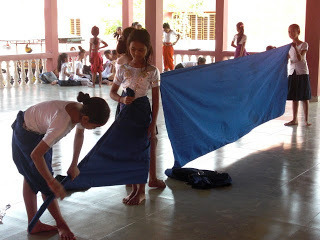 preparing the sampot chang kben
preparing the sampot chang kben
 adding a beltThen in groups they practiced their demanding poses--symbolic hand gestures and extensions, knee flexing, back arching, and stepping with toes lifted, much while chanting.
adding a beltThen in groups they practiced their demanding poses--symbolic hand gestures and extensions, knee flexing, back arching, and stepping with toes lifted, much while chanting.
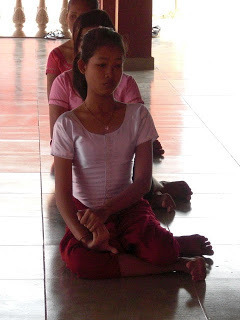 starting the exercises
starting the exercises
 moving through the exercisesDancer ages ranged from young girls just beginning to those who'd been dancing for nine years. This video shows some of the exercises.
moving through the exercisesDancer ages ranged from young girls just beginning to those who'd been dancing for nine years. This video shows some of the exercises.
An accompanist played a rompeat xylophone.
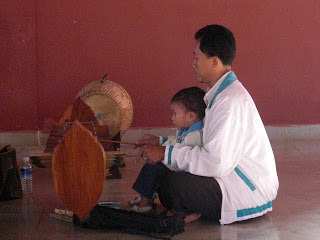 rompeat accompanistI also peeked in on the boys who were rehearsing monkey dance, an acrobatic male role from the Reamker, the Cambodian version of the Ramayana.
rompeat accompanistI also peeked in on the boys who were rehearsing monkey dance, an acrobatic male role from the Reamker, the Cambodian version of the Ramayana.
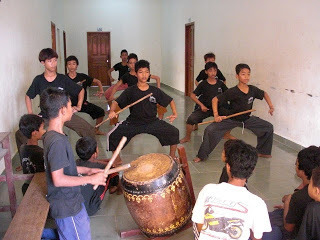 monkey dancers in rehearsalThroughout my time in Cambodia, I saw as much dance as I could. The highlight was a performance of classical and folk dance that I helped arrange for Yokohama International School students who were visiting Cambodia on a school building mission. The performance took place at the Secondary School of Fine Arts on my last evening in Phnom Penh. The money we raised will pay for new dance costumes and other much needed materials.
monkey dancers in rehearsalThroughout my time in Cambodia, I saw as much dance as I could. The highlight was a performance of classical and folk dance that I helped arrange for Yokohama International School students who were visiting Cambodia on a school building mission. The performance took place at the Secondary School of Fine Arts on my last evening in Phnom Penh. The money we raised will pay for new dance costumes and other much needed materials.
 performing the welcome or blessing dance
performing the welcome or blessing dance
 the coconut dance, a folk dance
the coconut dance, a folk dance
 Hanuman's army of monkeys
Hanuman's army of monkeys
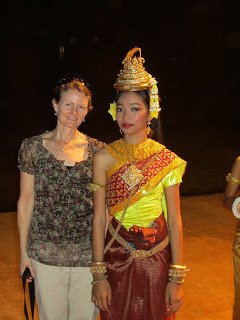 after the performance with one of the School of Fine Arts dancersCambodian classical and folk dance has survived despite the grim Pol Pot years. My hope is that Cambodian dance will continue to be nurtured and developed and that better funding for dance schools and performers will make dance a viable life choice for more Cambodians.
after the performance with one of the School of Fine Arts dancersCambodian classical and folk dance has survived despite the grim Pol Pot years. My hope is that Cambodian dance will continue to be nurtured and developed and that better funding for dance schools and performers will make dance a viable life choice for more Cambodians.
In Phnom Penh, I was fortunate to visit the Secondary School of Fine Arts at Russei Keo, the new, rather inconveniently located campus for the Royal University of Fine Arts dance school. A thirty-minute ride from the center of the city, I arrived by tuk-tuk as some of the dancers were still arriving by motor scooter.
Most classical dance roles are danced by women, so first I watched the girls. In an open-air pavilion, about 100 girls were preparing their sampot chang kben, the sarong-like cloth used to make trousers.
 preparing the sampot chang kben
preparing the sampot chang kben
 adding a beltThen in groups they practiced their demanding poses--symbolic hand gestures and extensions, knee flexing, back arching, and stepping with toes lifted, much while chanting.
adding a beltThen in groups they practiced their demanding poses--symbolic hand gestures and extensions, knee flexing, back arching, and stepping with toes lifted, much while chanting.  starting the exercises
starting the exercises
 moving through the exercisesDancer ages ranged from young girls just beginning to those who'd been dancing for nine years. This video shows some of the exercises.
moving through the exercisesDancer ages ranged from young girls just beginning to those who'd been dancing for nine years. This video shows some of the exercises.An accompanist played a rompeat xylophone.
 rompeat accompanistI also peeked in on the boys who were rehearsing monkey dance, an acrobatic male role from the Reamker, the Cambodian version of the Ramayana.
rompeat accompanistI also peeked in on the boys who were rehearsing monkey dance, an acrobatic male role from the Reamker, the Cambodian version of the Ramayana. monkey dancers in rehearsalThroughout my time in Cambodia, I saw as much dance as I could. The highlight was a performance of classical and folk dance that I helped arrange for Yokohama International School students who were visiting Cambodia on a school building mission. The performance took place at the Secondary School of Fine Arts on my last evening in Phnom Penh. The money we raised will pay for new dance costumes and other much needed materials.
monkey dancers in rehearsalThroughout my time in Cambodia, I saw as much dance as I could. The highlight was a performance of classical and folk dance that I helped arrange for Yokohama International School students who were visiting Cambodia on a school building mission. The performance took place at the Secondary School of Fine Arts on my last evening in Phnom Penh. The money we raised will pay for new dance costumes and other much needed materials.  performing the welcome or blessing dance
performing the welcome or blessing dance
 the coconut dance, a folk dance
the coconut dance, a folk dance
 Hanuman's army of monkeys
Hanuman's army of monkeys
 after the performance with one of the School of Fine Arts dancersCambodian classical and folk dance has survived despite the grim Pol Pot years. My hope is that Cambodian dance will continue to be nurtured and developed and that better funding for dance schools and performers will make dance a viable life choice for more Cambodians.
after the performance with one of the School of Fine Arts dancersCambodian classical and folk dance has survived despite the grim Pol Pot years. My hope is that Cambodian dance will continue to be nurtured and developed and that better funding for dance schools and performers will make dance a viable life choice for more Cambodians.
Published on March 01, 2011 19:31
February 21, 2011
ORCHARDS Publication Day!
Today is launch day for Orchards.
A huge bouquet of orchids and carnations just arrived--from my agent in California to my home in Japan. Thanks, Jamie!

I have a bowl of Shizuoka mikan ready for our family's mikan toast.
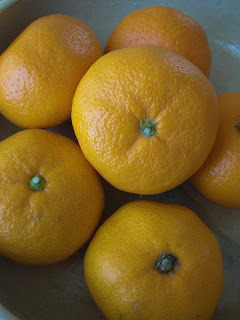
So get yourself a mikan, mandarin, clementine, tangerine, pomelo, or any sort of orange, and across oceans and mountains, wherever you are, please join me in celebrating the publication of Orchards.
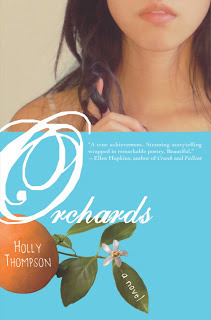

A huge bouquet of orchids and carnations just arrived--from my agent in California to my home in Japan. Thanks, Jamie!

I have a bowl of Shizuoka mikan ready for our family's mikan toast.

So get yourself a mikan, mandarin, clementine, tangerine, pomelo, or any sort of orange, and across oceans and mountains, wherever you are, please join me in celebrating the publication of Orchards.

Published on February 21, 2011 20:23
SCBWI NY 2011, Egypt and ORCHARDS
Just as I arrived in New York for the SCBWI New York conference at the end of January, the protests in Egypt heated up...which might not seem relevant, except that my son was studying abroad there. My attention quickly left the conference and was focused on his safety as security around his dorm and in his neighborhood deteriorated. I participated in the SCBWI Writers' Intensive day as best I could while periodically excusing myself to check for calls and try repeatedly to make contact with our son. It was an anxious time, but how great to be surrounded by the big extended SCBWI family during such a time of stress.
I ended up remaining in New York after the conference rather than traveling down to Washington, DC for AWP where I was supposed to appear on a poetry panel. Eventually my son was evacuated from Egypt and landed at JFK, with nothing but the clothes on his back and his computer. For the next week, my attention was on him as he debriefed from the tense situation and we set about determining his next steps...and buying clothes.
Egypt turmoil notwithstanding, I did manage a brief visit with my editor Francoise Bui at Delacorte/Random House where I was presented with a final bound copy of Orchards!
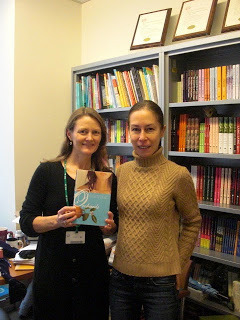
And I presented Francoise with this basket of mikan (actually mikan-shaped containers of hand lotion and lip balm).
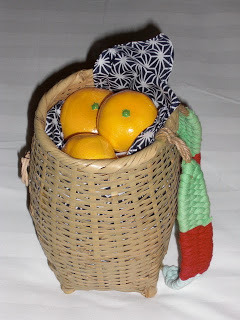
Of course, I did manage to show off Orchards to a few writer friends...
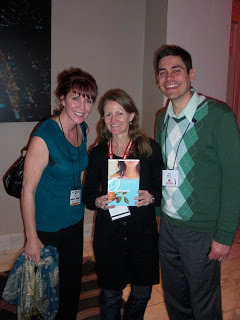
and share the moment with agent Mary Kole of Andrea Brown Literary Agency.
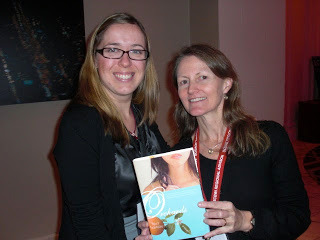
I also enjoyed meeting up with the other international SCBWI regional advisors--those in attendance for this conference were RAs from France, Israel, Germany, Greece and the British Isles.
 So if I missed you at SCBWI NY or AWP, forgive me. Hopefully at my next conferences I'll be able to focus on the presentations and the great company of writers and illustrators and not revolutions unfolding in the Middle East.
So if I missed you at SCBWI NY or AWP, forgive me. Hopefully at my next conferences I'll be able to focus on the presentations and the great company of writers and illustrators and not revolutions unfolding in the Middle East.
I ended up remaining in New York after the conference rather than traveling down to Washington, DC for AWP where I was supposed to appear on a poetry panel. Eventually my son was evacuated from Egypt and landed at JFK, with nothing but the clothes on his back and his computer. For the next week, my attention was on him as he debriefed from the tense situation and we set about determining his next steps...and buying clothes.
Egypt turmoil notwithstanding, I did manage a brief visit with my editor Francoise Bui at Delacorte/Random House where I was presented with a final bound copy of Orchards!

And I presented Francoise with this basket of mikan (actually mikan-shaped containers of hand lotion and lip balm).

Of course, I did manage to show off Orchards to a few writer friends...

and share the moment with agent Mary Kole of Andrea Brown Literary Agency.

I also enjoyed meeting up with the other international SCBWI regional advisors--those in attendance for this conference were RAs from France, Israel, Germany, Greece and the British Isles.
 So if I missed you at SCBWI NY or AWP, forgive me. Hopefully at my next conferences I'll be able to focus on the presentations and the great company of writers and illustrators and not revolutions unfolding in the Middle East.
So if I missed you at SCBWI NY or AWP, forgive me. Hopefully at my next conferences I'll be able to focus on the presentations and the great company of writers and illustrators and not revolutions unfolding in the Middle East.
Published on February 21, 2011 07:47
January 25, 2011
SCBWI NY Writers' Intensives-and the first sharing of Orchards
Today I printed out the manuscripts that I'll share during the Writers' Intensive of the annual SCBWI New York Winter Conference. At this intensive, a group of nine writers plus an agent or editor discuss each writer's work in turn during a two-hour session; writers are assigned a morning and afternoon session with different groups, and writers can share the same work or two different works.
I find intensives extremely valuable. I don't sign up just to get feedback on my own writing. I love to hear agent and editor reactions to all the various pieces, and I love to learn from the suggestions that the writers offer each other.
Sometimes the work I share at an intensive is submission ready. Other times, when I am trying a new genre or form, it is raw and incomplete. Several years ago at one of these New York SCBWI writers' intensives, I shared the beginning pages of an untitled manuscript. The piece, in first person verse, did not yet have any clear direction or plot. I had no idea if I was writing a short story, a poem or a novel. I thought the voice was YA but wasn't certain. I handed it out to the editor and the writers in my group with great trepidation and apologies that this was a very new piece of writing.
But at least some of my words resonated with the readers, and many helpful comments and questions were generated. Midway through the discussion the editor asked what my main character's name was. I swallowed, mortified. My character did not even have a name yet. But I had a story thread and emotion, and the words of encouragement from the editor and the writers in that session fueled me to start drafting a novel from that scrap of a beginning. Now, four years later I am counting down to February 22nd, when Orchards, the YA verse novel that developed from that simple beginning, will be published by Delacorte/Random House.
This week I'll bring new work to the intensives, and I look forward to hearing the feedback. I look forward to jumping into the exchange of ideas and to offering doses of that all-important encouragement to other writers. Then I look forward to coming back home, fueled by fresh suggestions and approaches, and setting to work again on my stories.
I find intensives extremely valuable. I don't sign up just to get feedback on my own writing. I love to hear agent and editor reactions to all the various pieces, and I love to learn from the suggestions that the writers offer each other.
Sometimes the work I share at an intensive is submission ready. Other times, when I am trying a new genre or form, it is raw and incomplete. Several years ago at one of these New York SCBWI writers' intensives, I shared the beginning pages of an untitled manuscript. The piece, in first person verse, did not yet have any clear direction or plot. I had no idea if I was writing a short story, a poem or a novel. I thought the voice was YA but wasn't certain. I handed it out to the editor and the writers in my group with great trepidation and apologies that this was a very new piece of writing.
But at least some of my words resonated with the readers, and many helpful comments and questions were generated. Midway through the discussion the editor asked what my main character's name was. I swallowed, mortified. My character did not even have a name yet. But I had a story thread and emotion, and the words of encouragement from the editor and the writers in that session fueled me to start drafting a novel from that scrap of a beginning. Now, four years later I am counting down to February 22nd, when Orchards, the YA verse novel that developed from that simple beginning, will be published by Delacorte/Random House.
This week I'll bring new work to the intensives, and I look forward to hearing the feedback. I look forward to jumping into the exchange of ideas and to offering doses of that all-important encouragement to other writers. Then I look forward to coming back home, fueled by fresh suggestions and approaches, and setting to work again on my stories.
Published on January 25, 2011 15:09
January 20, 2011
Manjiro and Heart of a Samurai
Last week, as I in the middle of reading Margi Preus's middle-grade novel Heart of a Samurai, the ALA awards were announced with Heart of a Samurai winning a Newbery Honor. Hooray for Margi! And how great to have a novel about the fascinating life of bicultural Nakahama Manjiro (中浜万次郎), aka John Manjiro, aka John Mung, win such high honors.
 I'd been looking forward to the release of this book since Margi told me about it during one of her research trips to Japan. As I told Margi, Manjiro first drew my attention when our son acted in a school production of the play The Navigator about the life of Manjiro, prompting us to do some research and background reading. When mikan research led me to Ehime, Shikoku, I extended the trip, brought the kids, and add some Manjiro-related exploration.
I'd been looking forward to the release of this book since Margi told me about it during one of her research trips to Japan. As I told Margi, Manjiro first drew my attention when our son acted in a school production of the play The Navigator about the life of Manjiro, prompting us to do some research and background reading. When mikan research led me to Ehime, Shikoku, I extended the trip, brought the kids, and add some Manjiro-related exploration.
After much of the week visiting and interviewing mikan growers from the cooperative Muchachaen in Maihama, we headed south. The coastline of southwest Shikoku is rugged, remote and spectacular.
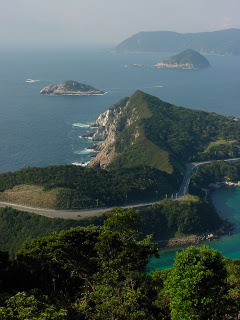
At Cape Ashizuri we visited the John Mung House, actually a museum, which looks out onto this stone arch.
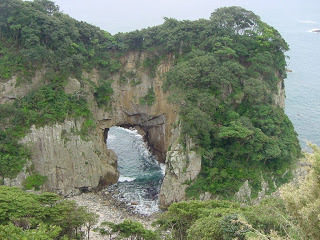
We explored the southernmost tip of Shikoku, visited the temple Kongofukuji and found the nearby statue of John Manjiro. We pored over exhibits in the John Mung House museum and drove to the town of Nakanohama, Manjiro's birthplace, where our son, at just about the age of Manjiro when his boat went adrift, had me take his photo by the stone marker.
The area is not easy to reach even now, and a boy from a fishing family in the mid-1800s certainly lived an isolated life. From that simple existence, after a harrowing shipwreck, Manjiro was rescued, learned navigation on a whaling ship, attended school in a Massachusetts whaling town, panned for gold in the Sierra Nevada, and spent more years on a whaling ship before managing to return to Japan as the country was just beginning to open up to the outside world. This Japan Times article "One of a Kind" has intriguing background info about Manjiro's unusual life.
Readers interested in whaling in the nineteenth century might want to pair Heart of a Samurai with If Ever I Return Again by Corinne Demas about a girl on her father's whaling ship in 1856 who also becomes a skilled navigator.
 I'd been looking forward to the release of this book since Margi told me about it during one of her research trips to Japan. As I told Margi, Manjiro first drew my attention when our son acted in a school production of the play The Navigator about the life of Manjiro, prompting us to do some research and background reading. When mikan research led me to Ehime, Shikoku, I extended the trip, brought the kids, and add some Manjiro-related exploration.
I'd been looking forward to the release of this book since Margi told me about it during one of her research trips to Japan. As I told Margi, Manjiro first drew my attention when our son acted in a school production of the play The Navigator about the life of Manjiro, prompting us to do some research and background reading. When mikan research led me to Ehime, Shikoku, I extended the trip, brought the kids, and add some Manjiro-related exploration.After much of the week visiting and interviewing mikan growers from the cooperative Muchachaen in Maihama, we headed south. The coastline of southwest Shikoku is rugged, remote and spectacular.

At Cape Ashizuri we visited the John Mung House, actually a museum, which looks out onto this stone arch.

We explored the southernmost tip of Shikoku, visited the temple Kongofukuji and found the nearby statue of John Manjiro. We pored over exhibits in the John Mung House museum and drove to the town of Nakanohama, Manjiro's birthplace, where our son, at just about the age of Manjiro when his boat went adrift, had me take his photo by the stone marker.
The area is not easy to reach even now, and a boy from a fishing family in the mid-1800s certainly lived an isolated life. From that simple existence, after a harrowing shipwreck, Manjiro was rescued, learned navigation on a whaling ship, attended school in a Massachusetts whaling town, panned for gold in the Sierra Nevada, and spent more years on a whaling ship before managing to return to Japan as the country was just beginning to open up to the outside world. This Japan Times article "One of a Kind" has intriguing background info about Manjiro's unusual life.
Readers interested in whaling in the nineteenth century might want to pair Heart of a Samurai with If Ever I Return Again by Corinne Demas about a girl on her father's whaling ship in 1856 who also becomes a skilled navigator.
Published on January 20, 2011 16:28
January 7, 2011
Kamakura New Year
Kamakura is a great place to ring in the new year...both because of and in spite of the crowds. First of all the weather is more like autumn.
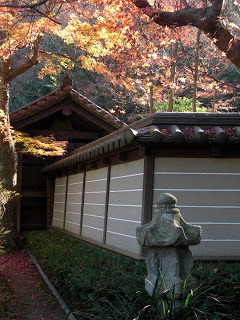 Zuisenji
Zuisenji
 Zuisenji stepsOur local sake merchant sets up taru (casks) of sake from all around Japan that we can sample and purchase by the liter.
Zuisenji stepsOur local sake merchant sets up taru (casks) of sake from all around Japan that we can sample and purchase by the liter.
 sake taruThere are many lantern-lit temples to choose from for the midnight bell ringing.
sake taruThere are many lantern-lit temples to choose from for the midnight bell ringing.
 Lanterns at Hongakuji
Lanterns at Hongakuji
 Ceremonies before the bell ringing at Hongakuji New Year's decorations are everywhere
Ceremonies before the bell ringing at Hongakuji New Year's decorations are everywhere
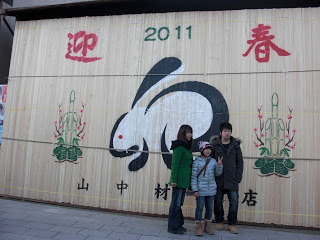 Lumber shop with New Year's rabbit painted on the boards
Lumber shop with New Year's rabbit painted on the boards
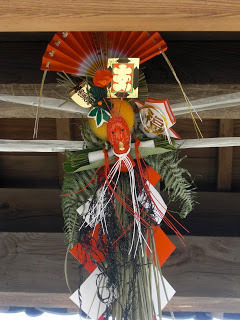 Gate decoration at KomyojiAnd of course there is Tsurugaoka Hachimangu for the first shrine visit of the year. Here is the crowd scene on January 1...
Gate decoration at KomyojiAnd of course there is Tsurugaoka Hachimangu for the first shrine visit of the year. Here is the crowd scene on January 1...
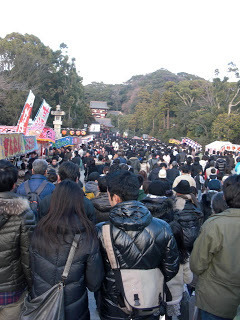 Waiting in line to visit Hachimangu Jan. 1, 2011After an hour's wait, we are nearing the stairs...
Waiting in line to visit Hachimangu Jan. 1, 2011After an hour's wait, we are nearing the stairs...
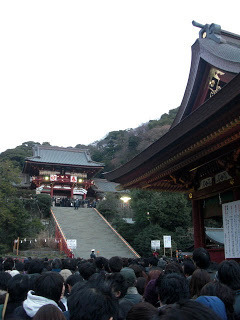 By the maiden pavilion facing the main shrineAnd finally it's dusk by the time we reach the top, toss a coin into the money box, and bow and clap and pray in a jostling mass.
By the maiden pavilion facing the main shrineAnd finally it's dusk by the time we reach the top, toss a coin into the money box, and bow and clap and pray in a jostling mass.
 View from Hachiman ShrineSo now it's deep winter...
View from Hachiman ShrineSo now it's deep winter...
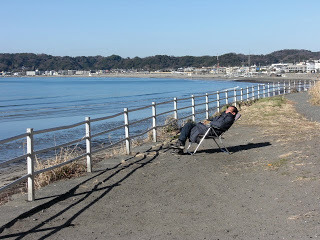
which in Kamakura is really pretty mellow.


 Zuisenji
Zuisenji
 Zuisenji stepsOur local sake merchant sets up taru (casks) of sake from all around Japan that we can sample and purchase by the liter.
Zuisenji stepsOur local sake merchant sets up taru (casks) of sake from all around Japan that we can sample and purchase by the liter.
 sake taruThere are many lantern-lit temples to choose from for the midnight bell ringing.
sake taruThere are many lantern-lit temples to choose from for the midnight bell ringing. Lanterns at Hongakuji
Lanterns at Hongakuji
 Ceremonies before the bell ringing at Hongakuji New Year's decorations are everywhere
Ceremonies before the bell ringing at Hongakuji New Year's decorations are everywhere Lumber shop with New Year's rabbit painted on the boards
Lumber shop with New Year's rabbit painted on the boards
 Gate decoration at KomyojiAnd of course there is Tsurugaoka Hachimangu for the first shrine visit of the year. Here is the crowd scene on January 1...
Gate decoration at KomyojiAnd of course there is Tsurugaoka Hachimangu for the first shrine visit of the year. Here is the crowd scene on January 1... Waiting in line to visit Hachimangu Jan. 1, 2011After an hour's wait, we are nearing the stairs...
Waiting in line to visit Hachimangu Jan. 1, 2011After an hour's wait, we are nearing the stairs...
 By the maiden pavilion facing the main shrineAnd finally it's dusk by the time we reach the top, toss a coin into the money box, and bow and clap and pray in a jostling mass.
By the maiden pavilion facing the main shrineAnd finally it's dusk by the time we reach the top, toss a coin into the money box, and bow and clap and pray in a jostling mass. View from Hachiman ShrineSo now it's deep winter...
View from Hachiman ShrineSo now it's deep winter...
which in Kamakura is really pretty mellow.

Published on January 07, 2011 20:34
December 31, 2010
A Look Back on Writing 2010
It's time to take stock of what I've written in 2010. Since as a writer I always feel behind, like I haven't done nearly enough, like I'm sinking under the weight of all my projects, periodically I need to remind myself of what I have managed to accomplish.
First, I finished my YA verse novel Orchards, which is due out from Delacorte/Random House in February 2011.
 What a pleasure it was to work on the fine tuning of the manuscript this year with my Delacorte editor Francoise Bui and to be able to share my thoughts and suggestions for the spot illustrations. I can't wait to see the final hardcover copy.
What a pleasure it was to work on the fine tuning of the manuscript this year with my Delacorte editor Francoise Bui and to be able to share my thoughts and suggestions for the spot illustrations. I can't wait to see the final hardcover copy.
In the beginning of 2010 I set to work on another YA verse novel, which is now up to about 300 pages. Research for this new novel has taken me to Lowell, Massachusetts, to various health care providers, and will take me to Cambodia in 2011. Each book I write sends me on a new, eye-opening journey.
In April I tackled the Poem a Day challenge and wrote thirty new poems. More recently, in November, I wrote 30 picture book ideas for Picture Book Idea Month and managed 26 poems for Poem A Day Chapbook Challenge. I just posted to my poetry group two revised poems from that PAD challenge for this month's cririques.
I also revised picture books, and I researched and wrote two new picture books. Now and then through the year I've had moments to revisit my adult novel-in-progress and collection of short stories. And I've written a number of articles including those for Wingspan, the ANA inflight magazine.
So when I'm being hard on myself and feeling that my weekly or monthly word count is deficient, or that other writers are doing more, I have to remind myself that word by word, page by page...between the full-time job, family, and myriad other obligations...books, stories, poems and articles are, in fact, getting written. Here's to many words in 2011!
First, I finished my YA verse novel Orchards, which is due out from Delacorte/Random House in February 2011.
 What a pleasure it was to work on the fine tuning of the manuscript this year with my Delacorte editor Francoise Bui and to be able to share my thoughts and suggestions for the spot illustrations. I can't wait to see the final hardcover copy.
What a pleasure it was to work on the fine tuning of the manuscript this year with my Delacorte editor Francoise Bui and to be able to share my thoughts and suggestions for the spot illustrations. I can't wait to see the final hardcover copy.In the beginning of 2010 I set to work on another YA verse novel, which is now up to about 300 pages. Research for this new novel has taken me to Lowell, Massachusetts, to various health care providers, and will take me to Cambodia in 2011. Each book I write sends me on a new, eye-opening journey.
In April I tackled the Poem a Day challenge and wrote thirty new poems. More recently, in November, I wrote 30 picture book ideas for Picture Book Idea Month and managed 26 poems for Poem A Day Chapbook Challenge. I just posted to my poetry group two revised poems from that PAD challenge for this month's cririques.
I also revised picture books, and I researched and wrote two new picture books. Now and then through the year I've had moments to revisit my adult novel-in-progress and collection of short stories. And I've written a number of articles including those for Wingspan, the ANA inflight magazine.
So when I'm being hard on myself and feeling that my weekly or monthly word count is deficient, or that other writers are doing more, I have to remind myself that word by word, page by page...between the full-time job, family, and myriad other obligations...books, stories, poems and articles are, in fact, getting written. Here's to many words in 2011!
Published on December 31, 2010 01:42



